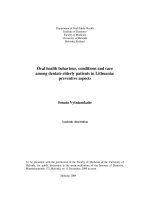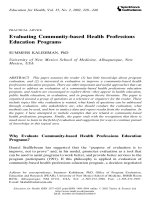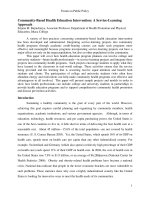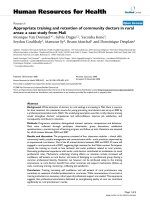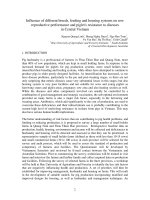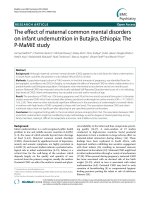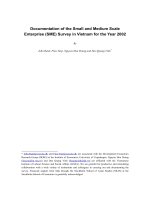Role of community based health insurance on health service provision and healthcare seeking behavior of households in rural ethiopia the case of tehuledere district, south wollo zone
Bạn đang xem bản rút gọn của tài liệu. Xem và tải ngay bản đầy đủ của tài liệu tại đây (1.27 MB, 140 trang )
Addis Ababa University
School of Graduate Studies
Department of Sociology
Role of Community Based Health Insurance on Health Service provision and
Healthcare Seeking Behavior of Households in Rural Ethiopia: the Case of
Tehuledere District, South Wollo Zone
By
Molla Yismaw Jembere
June, 2017
Addis Ababa, Ethiopia
1
Addis Ababa University
School of Graduate Studies
Department of Sociology
Role of Community Based Health Insurance on Health Service provision and
Healthcare Seeking Behavior of Households in Rural Ethiopia: the Case of
Tehuledere District, South Wollo Zone
A Thesis Submitted to the School of Graduate Studies of Addis Ababa
University in Partial Fulfillment of the Requirements for the Degree of Master
of Arts in Sociology
By
Molla Yismaw Jembere
Advisor
Kassahun Asress (PhD)
June, 2017
Addis Ababa, Ethiopia
2
Addis Ababa University
School of Graduate Studies
Department of Sociology
Declaration
I, Molla Yismaw Jembere, hereby declare that the thesis entitled: “Role of Community Based
Health Insurance on Health Service provision and Healthcare Seeking Behavior of
Households in Rural Ethiopia: the Case of Tehuledere District, South Wollo Zone”, submitted
by me to award of the Degree of Master of Arts in Sociology at Addis Ababa University, is a
product of my original work and it hasn’t been presented for the award of any other Degree,
Diploma, Fellowship of any other university or institution. This work has also accredited the
views of the research participants. To the best of my knowledge, I have fully acknowledged the
materials and pieces of information used in the study.
Name: Molla Yismaw Jembere
Signature________________
Date of Submission: June, 2017
Department of Sociology, Addis Ababa University
3
Addis Ababa University
School of Graduate Studies
Department of Sociology
Certification
This is to certify that this thesis entitled: “Role of Community Based Health Insurance on
Health Service provision and Healthcare Seeking Behavior of Households in Rural Ethiopia:
the Case of Tehuledere District, South Wollo Zone’’, prepared by Molla Yismaw and submitted
in partial fulfillment of the requirements for the award of degree of Master of Arts in Sociology
complies with the regulation of the University and meets the accepted standards with respect to
originality and quality.
Approved By Boards of Advisor and Examiners
Advisor
Signature
_______________________
Internal Examiner
_______________________
External Examiner
_______________________
_________________
Signature
_________________
Signature
_________________
Date
______________
Date
______________
Date
______________
4
Acknowledgments
This thesis would not have been possible without the contribution and support of a number of
individuals and organizations. First and foremost, I would like to express my deepest gratitude to
my advisor Dr. Kassahun Aseress for his unreserved effort in the course of conducting this study
from the beginning to the completion. The moral encouragement, friendly, thoughtful, and
inspiring approach of Dr. Kassahu has buoyant me to aim higher and irreplaceable in my future
academic career. I am truly and deeply indebted to his guidance, patience, and constant faith and
confidence in me as a student. Really, I learned a lot about research from the perceptive
comments, suggestions and explanations he made available and experiences he shared.
A special thanks to my family who give me unconditional love, their moral support and
encouragement, which motivated me to keep pursuing my study.
I am also very grateful to officials in Ethiopian Health Sector Reform Project Office, South
Wollo Zone health insurance offices, Tehuledere District; health insurance, administrative and
health offices for their kind cooperation in providing the necessary support and easing
administrative bureaucracies and taking part directly in facilitating the contact with the study
population.
I express my deepest gratitude to all respondents and informants who participated in this study
without their collaboration producing this thesis would have been impossible. I would like to
thank my enumerators: Habtamu Berihun, Mohammed Nuru, Hana Berihun, Tsegaye Dinku and
Ali Ahmed. My heartfelt thank is also due to my field assistants, particularly, Mr. Teshome;
Tehuledere District health insurance office team leader for facilitating my contact with the
facilitators and study participants.
Not to be forgotten are a number of people who contributed one way or another to the
completion of this thesis. I would like to extend my gratitude to my friends Antehunegn
Berhanu, Menberu Bekabil, Moges Gebre, Chekol Hadis, Feraol Girma, Tadele Workneh and
Endalkachew Girma for sharing comments and suggestions with me about my study.
Finally, I would like to thank Addis Ababa University for providing the financial assistance
needed for the study. I am also indebted to Wollo University to give me scholarship for this
academic endeavor.
i
Table of Contents
Contents
Page
Acknowledgments............................................................................................................................ i
Table of Contents ............................................................................................................................ ii
List of Tables ................................................................................................................................ vii
List of Figures ................................................................................................................................ ix
Acronyms and abbreviations............................................................................................................x
Abstract .......................................................................................................................................... xi
Chapter One: Introduction ...............................................................................................................1
1.1. Background of the Study ................................................................................................................... 1
1.2. Statement of the problem ................................................................................................................... 4
1.3. Objectives of the Study ...................................................................................................................... 8
1.3.1. General Objective of the Study ................................................................................................... 8
1.3.2. Specific objectives of the study................................................................................................... 8
1.4. Significance of the Study ................................................................................................................... 9
1.5. Concepts and measurements of key terms ......................................................................................... 9
1.5.1. Conceptual definition .................................................................................................................. 9
1.6. Delimitation of the Study ........................................................................................................11
1.7. Organization of the Thesis ............................................................................................................... 11
Chapter Two: Review of Related Literature ..................................................................................12
2.1. Fundamental Assumptions of Community Based Health Insurance Scheme .................................. 12
2.2. Design of Community Based Health Insurances ............................................................................. 12
2.3. Community Based Health Insurances in Africa ............................................................................... 15
2.4. Health care financing in Ethiopia..................................................................................................... 15
2.4.1. Ethiopian Community Based Health Insurance ........................................................................ 16
ii
2.4.2. Designing of Community Based Health Insurance in Ethiopia ................................................ 16
2.4.3. Implementations of Community Based Health Insurance in Ethiopia ...................................... 17
2.5. Impact of Community Based Health Insurances scheme ................................................................. 18
2.5.1. The Impact of CBHI on Access to Health Care Services ......................................................... 18
2.5.2. The Impact of CBHI scheme on Quality of Health Care Services............................................ 19
2.6. Understanding Health Care Seeking Behavior ................................................................................ 21
2.6.1. Impact of CBHI Scheme on the Health Care Seeking Behavior of Households ...................... 22
2.7. Limitation and Constraints of Community Based Health Insurances .............................................. 22
2.8. Conceptual and Theoretical Framework of the Study...................................................................... 24
2. 8.1. Andersen’s Socio-Behavioral Model of Health Service Utilization ........................................ 24
2.8.2. Health Belief Model (HBM) .................................................................................................... 26
2.8.3. Synthesizing Socio-Behavioral Model of Health Service Utilization and Health belief model 27
Chapter Three: Research Methodology .........................................................................................29
3.1. Description of the Study Area and Justification of Study Site Selection ......................................... 29
3.1.1. Description of the Study Area ................................................................................................... 29
3.1.2.. Justification for Study Site Selection ....................................................................................... 31
3.2. Study Design ...........................................................................................................................31
3.3. Research Approach: Quantitative and Qualitative ................................................................32
3.4. Method and Instrument of Data Collection for Quantitative Data ....................................................... 32
3.4. 1. Household Survey .................................................................................................................... 32
3.4.2. Study Population and Sampling Design for Household survey ................................................ 33
3.5. Method and Instrument of Data Collection for Qualitative Data ......................................................... 36
3.5.1. Study Population and Sampling Design for Qualitative Data ................................................... 36
3.5.2. In-depth interviews ................................................................................................................... 37
3.5.3. Key- Informant Interview ......................................................................................................... 38
3.5.4. Focus group discussion (FGD) ................................................................................................. 38
iii
3.6. Sources of Data ................................................................................................................................ 39
3.6.1. Primary Source of Data ............................................................................................................. 39
3.6. 2. Secondary Data Sources........................................................................................................... 39
3.7. Procedures of data collection........................................................................................................... 40
3.8. Operationalization of Concepts ........................................................................................................ 41
3.9. Methodological Triangulation.......................................................................................................... 42
3.10. Method of Data Entry and Analysis ............................................................................................... 43
3.11. Data Quality Assurance ................................................................................................................. 43
3.12. Limitations of the Study................................................................................................................. 44
3.13. Field Challenges and Experiences ................................................................................................. 44
3.14. Ethical Consideration ..................................................................................................................... 45
Chapter Four: Data Presentation, Analysis and Interpretation ......................................................46
4.1. Background Characteristics of Respondents.................................................................................... 46
4.1.1. Sex, Age Composition and Marital Status of the Respondents................................................. 46
4.1.2. Family Size of the Respondents ................................................................................................ 47
4.1.3. Educational Level of Respondent ............................................................................................. 48
4.1.4. Respondent ownership of Cultivable Farm Land...................................................................... 48
4.1.5. Respondents Level of Income ................................................................................................... 48
4.2. Planning and Implementation of CBHI Scheme in the Study Area ................................................. 48
4.2.1. Planning of CBHI scheme in Tehuledere District..................................................................... 49
4.2.2.
Implementation of CBHI scheme in Tehuledere District.................................................... 52
4.2.3. Level of awareness and membership condition to the scheme ................................................. 52
4.2.4. Benefit package and Community Role in Managements and Administration of the Scheme .. 53
4.2.5. Reasons for Membership to community based health insurance .............................................. 54
4.2.6. Duration of Membership and Premium to Community Based CBHI Scheme.......................... 55
4.3. Impact of CBHI Scheme on Quality of Health care provision, access and customer satisfaction ... 57
iv
4.3.1. Improvement in overall quality of Health Service Provision.................................................... 58
4.3.2. Improvement in Availability of Drug Supply ........................................................................... 60
4.3.3. Improvement in availability of laboratory services .................................................................. 61
4.3.4. Improvement in waiting time to get services ............................................................................ 62
4.3.5. Improvement in referral system ................................................................................................ 63
4.3.6. Improvement in staff motivation............................................................................................... 65
4.3.7. Improvement in cleanness of the healthcare institution ............................................................ 65
4.3.8. Impact of CBHI scheme on Customers satisfaction ................................................................. 66
4.3.9. Impact of CBHI Scheme on Access to Healthcare Services ..................................................... 68
4.4. Impact of CBHI Scheme on Healthcare Seeking Behavior and Health Service Utilizations .......... 69
4.4.1. Occurrences of Illness and Immediate Responses .................................................................... 70
4.4.2. Impact of CBHI Scheme on Treatment Choices ....................................................................... 71
4.4. 3. Preference to Health Care Institutions ..................................................................................... 72
4.4. 4. Access to Information and Adherences for Prescriptions ........................................................ 73
4.4.5. The Impact of CBHI in Promoting Delay and Utilizations of Healthcare Service ................... 74
4.4.6. Frequency of Healthcare Utilization in terms of Sex and Age Categories ............................... 77
4.4.7. Predisposing Factors (Socio- Demographic Characteristics) and Health Service utilizations .. 78
4.4.8. Enabling factors and health services utilization ............................................................................ 79
4.4.9. Change in health services utilizations over years in the study area .......................................... 80
4. 5.Attitude of member households and perception of frontline health services providers towards
CBHI scheme .......................................................................................................................................... 82
4.5.1. Households attitude towards CBHI in prompting health condition of the community ............. 82
4.5.2. Attitudinal variations in various group category towards CBHI scheme.................................. 83
4.5.3. Community based health insurances and work load on health care services providers ............ 84
Chapter Five: Discussion, Implication and conclusion..................................................................89
5.1. Discussion ........................................................................................................................................ 89
v
5.2. Implications of the Study for Policy, Theory and Research ............................................................ 97
5.3. Conclusions ...................................................................................................................................... 98
Reference .......................................................................................................................................69
Annex I: Data Collecting Instruments ...........................................................................................78
Annex II: photograph and figure......................................................................................................6
vi
List of Tables
Table 2.1: Different designing features of CBHI scheme..............................................................14
Table: 3.1: Sample size determination for household survey ........................................................33
Table 3.2: Operationalization of Concepts ....................................................................................41
Table: 3.3: Methodological triangulation ......................................................................................42
Table 4-1: Socio-economic and Demographic Characteristics of Respondents ............................47
Table. 4.2. Plan and implementations of community based health insurances in Tehuledere
District, major parameters ..............................................................................................................50
Table 4.3, Reason/s for membership to community based health insurance .................................54
Table 4.4, Quality of healthcare services provisions after the introduction of community based
health insurance .............................................................................................................................58
Table 4.5, Level of satisfaction about health care services received from modern health care
facilities before and after the introduction of CBHI scheme .........................................................66
Table 4.6, Reasons/s for satisfaction or dissatisfactions by services received from modern health
care facilities after the introduction of CBHI scheme ...................................................................67
Table 4.7, Occurrences of illness and immediate responses ..........................................................70
Table 4.8, Types of treatment that the family member/s employed before and after member to
CBHI scheme .................................................................................................................................72
Table 4.9, Institutional preferences to get treatment......................................................................72
Table 4.10, Information access about treatment of diseases in modern health facilities ...............73
Table 4.11, Health service utilizations and delay ..........................................................................75
Table 4.12, Socio-demographic (predisposing) characteristics and health services utilization of
Respondents ...................................................................................................................................78
Table 4.13, Enabling variables and health services utilization of Respondents ............................80
Table 4.14, Change in services utilization from modern health facilities (2011-2017) ................81
Table 4.15, Likert scale measurements Adopted from Kothari, 2004 and Likert, 1932 ...............82
vii
Table 4.16, Households’ attitude towards community based health insurances............................83
Table 4.17, Attitude of insured household towards Community Based Health Insurance Scheme
in promoting health condition of the community ..........................................................................84
viii
List of Figures
Fig: 2.1, Healthcare seeking behavior based on Anderson and Newman Model of Health Care
Utilization (2005) ...........................................................................................................................26
Fig. 3.1: Map of the study area ......................................................................................................30
Fig.4.1, Overall quality of healthcare service provision after the introduction of community
based health insurance………………………………………………………………….…….….58
Fig. 4.2, Midwives case team Green Park at Sulula health center ………………….…...…..…..66
Fig 4.3, percentage of health care service utilizations in sex and age categories ……….....…....77
Fig.4.4. Annual rate of health services utilization per individual (2011-2016) ………..….……81
ix
Acronyms and abbreviations
ANOVA
CBHI
CSA
E.C
EDHS
EFY
EHIA
EIC
ETB
Ethio-GIS
FGD
Fig
FMoH
GDP
HBM
HSFR
HSHSTP
IDI
KII
LMIC
MOFED
NGO
OOP
OOPS
PASDEP
PFSA
SDPRP
SHI
SNNPR
SPSS
SRS
TV
UHC
UNDP
US
USAID
USD
WHO
Analysis of Variances
Community Based Health Insurance
[Ethiopian] Central Statistics Agency
Ethiopian Calendar
Ethiopian Demographic and Health Surveys
Ethiopian Fiscal Year
Ethiopia Health Insurance Agency
Ethiopian Insurance Corporation
Ethiopian Birr
Ethiopian Geographic System
Focus Group Discussion
Figure
[Ethiopian] Federal Ministry of Health
Growth Domestic Product
Health Belief Model
Health Sector Financing Reform
Health Sector Transformation Plan
In-depth Interview
Key Informant Interview
Low and Middle Income Countries
[Ethiopian] Ministry of Finance and Economic Development
Non Government Organization
Out- of -Pocket
out- of -Pocket Spending
Plan for Accelerated and Sustained Development to End Poverty
Pharmacy Fund and Supply Agency
Sustainable Development and Poverty Reduction Program
Social Health Insurances
Southern Nations, Nationalities and Peoples Region
Statistical Package for Social Science
Simple Random Sampling
Television
Universal Health Coverage
United Nation Development Program
United States
United States Agency for International Development
United States Dollar
World Health Organization
x
Abstract
The issue of community based health insurance is an emerging and promising concept to access
affordable and effective health care in low and middle income countries. Introduction of CBHI
scheme aims to mobilize additional resources to the health sector. More importantly,
substantially pooling risks between the poor and the better off as well as the sick and healthy
that improve equity, quality and access in health service delivery. In addition, as a health
insurance scheme removes or considerably reduce cash requirement at the point of getting
services, members will be encouraged to seek service when it is needed which ultimately
increase the demand for seeking care and utilization of the service. However, CBHI is limited in
most developing countries and out of pocket health care expenditure still impoverishes
households especially in rural and people in informal sector. So far, little has been done
regarding the role of CBHI on health care seeking behavior, access and quality of services in
developing countries in general and in Ethiopia in particular. Accordingly, the main objective of
this study was to examine services provision of health care providers and health care seeking
behavior of households in response to the introduction of CBHI scheme in rural Ethiopia:
particularly in Tehuledere District, South Wollo Zone. To conduct this study, mixed research
approach employed concurrently to gather data from 344 respondents (70% male and 30%
female) for household survey and informants of IDIs, KIIs and FGDs. The quantitative data were
analyzed using descriptive statistics such as table, percentage and graph on one hand, and
inferential statistics like, T-Test, one way ANOVA and correlation on the other hand were used
to verify the group difference and relationship across variables. Qualitative data were analyzed
using thematic analysis. The sampling design of this study used both probability (multistage
stage proportional sampling) and non-probability (purposive based on conveniences and
judgmental sampling until saturation achieved). The study finding disclosed that in some
parameters there were gaps in design and implementation of CBHI scheme. In addition, overall
quality of service improved though there were limitations in some quality indicator. Health
services utilization improved from 0.33 visits of individual per year in 2011 to 1.44 visits in
2016; more than four times from the previous visits. Majority of the respondents (93.3%) do
have positive or favorable attitude towards CBHI scheme and its role in promoting health
condition of the community. Furthermore, CBHI enable health care providers to prescribe the
appropriate diagnostic test and drugs without any uncertainties about the ability of the CBHI
member to pay. However, work load increases without increasing incentives; that resulted effect
on moral hazards and mistreatment of members. This study has a significant role in filling
research gaps, policy implication and sources of information within the limited literature on the
issue at hand.
Key Words: CBHI Scheme, Rural, Household, Health care Seeking Behavior, mixed approach
xi
Chapter One: Introduction
1.1. Background of the Study
Healthcare financing and access to affordable and effective healthcare is a major problem in low
and middle income countries (LMIC) and out of pocket expenditure for healthcare
1
become a
major cause of impoverishment such as, poverty (Jacobs et al. 2008; WHO 2010). Since 1980s,
most developing countries introduced user fees in order to improve availability of health care
facilities to improve access and quality of services (Carrin et al. 2005; Parmar et al. 2012). Later
in the 1990s, the financial difficulties associated with imposition of user fees brought drop out
from seeking health care service which resulted poor health condition in LMIC (Tabor 2005).
According to Wagstaff (2009), out of pocket payments create financial barriers that prevent
millions of people from seeking and receiving needed health service worldwide. Moreover, many
of those who do seek health care and pay for health care services are faced with financial burden
and poverty. People who suffer financial difficulties might forego health care services
utilizations. Carrin et al. (2008) stated that lack of ability to access health services; exorbitant
expenditure and impoverishment are strongly associated with the degree to which countries rely
on out-of-pocket payments as a means of financing their health care systems.
Similar to the aforementioned claim, the state of health care financing in Ethiopia over the years
has been characterized by low government spending and minimal participation of the private
sector. Health care expenditure in Ethiopia represented 6.2% of the total public budget, and 1.8%
of GDP in 2000 and only about 50% of the population has access to basic health services; and
drug supplies are irregular in most of the available facilities ( FMoH 2010; Wamai 2009).
Ethiopian health care system was largely reliant on out of pocket spending (OOPS), exposing
many households to financial hardship due to very expensive health expenditures or causing
them to give up seeking healthcare especially in rural Ethiopia (Anagaw 2015; FMoH 2010).
According to FMoH (2010), poor health care financing in Ethiopia slowdown health
Out of pocket expenditure (user fees) for healthcare services 1: defined as direct payments
made by individual to health service providers at the time of service use; that will not reimburse
and share risk.
1
1
improvements on access, quality and utilization of essential health services among the poor and
rural communities.
Healthcare financing in Ethiopia depend on government expenditure, donors and high out of
pocket user fees. For example in 1999/2000 the government and other public enterprises provide
31% of the financing, donors and NGOs provide 37%, households provide 31% and other private
employers and fund about 1% (FMoH 2005; MOFED 2008). A study conducted by FMoH
(2010) found out that out of pocket expenditures of households increased from 31% in1999/2000
to 37% in 2010 due to high reliance on out of pocket expenditure and low government spending
on the health sector.
In responses to high out of expenditure, low utilization and quality of services, one way to
facilitate access and overcome unaffordable expenditure is through a health insurance
mechanism, whereby risks are shared and financial inputs pooled through cross subsidizations
within people who sick frequently and unable to afford for health care, and people who are
healthy but pay premium for CBHI scheme within households (Ahuja and Jutting 2009).
Additionally, to deal with inequality in health care among households, there is widespread
consensus that providing universal, sustainable, affordable and quality health services underpins
efforts to achieve equitable health outcomes. Consequently, community based health insurance
is one approach and alternative to finance healthcare provision in the informal sector to increase
utilization of health services; rather than waiting for top-down tax-based financing or social
health insurances (SHI) development, bottom-up or CBHI has been introduced to low-income
countries over the past two decades for rural community and people who engaged in the informal
sector (Carrin, Mathauer and Evans 2008).
In many developing countries efforts are underway to improve quality, access, efficiency and
effectiveness of health care through reforming the way of health care financing (Tabor 2005).
Correspondingly, the government of Ethiopia introduced two types of health insurance schemes
in 2011. The first scheme know as social health insurance which is mandatory health insurance
program for formal sector employees including pensioners and financed by earmarked payroll
/pension contributions from employees and employers (FMoH 2008). Social health insurance is
in the planning phase but not yet implemented. The second is community based health insurance
2
(CBHI) scheme with the aim of enhancing access to health care and reducing the burden of out
of pocket healthcare expenditure for rural households and people engaged in the informal sectors
intended to cover 83.6% of the population (FMoH 2010).
Accordingly, the pilot CBHI scheme2 was tested in 13 Districts located in four regions (Tigray,
Amhara, Oromiya, and SNNPR) of the country in 2011 aimed at improving access to health care
services, reducing the burden of out of pocket expenditure, increasing quality of services to
balance high demand of health care and low supply of medical services basically for rural
households and people in urban informal sector (FMoH 2010; Anagaw 2015).
A study by FMoH (2011) stated that the designing of the Ethiopian CBHI scheme builds on the
assumption of certain features(parameters) such as, membership for enrollment is done voluntary
on a household basis; to reduce the possibility of adverse selection, financing the very poor
(indigents), regular premium, targeted subsidy , benefit package, community involvement in
management and administration of CBHI scheme and line of referral are considered main
features in the designing of CBHI scheme. In the pilot districts, households who join the
community-based health insurance are expected to pay 180 Birr (8.57 US$) annually as a
premium. Community based health insurance covers a wide variety of health insurance
arrangements or benefit packages. The benefits packages of CBHI in Ethiopia include all
curative and preventive care that are part of the essential health package in Ethiopia (FMoH
2008; FMoH 2010; FMoH 2011). Community based health insurances scheme brought a
potential to achieve universal coverage of health services through risk pooling and protect rural
household and informal sector population from costly health care expenditure (Jutting 2003).
The scheme is new for many developing countries particularly for Ethiopia. So, an investigation
about CBHI and its contribution in the health care system is imperative, as it changed households
access for healthcare service, improve healthcare seeking behavior and quality of service
provisions.
Consequently, this study examine health service provisions of frontline healthcare providers and
healthcare seeking behavior of households in rural Ethiopia following the introduction of
2
Pilot Districts to implement CBHI scheme were Tehuledere, Fogera, South Achefer, Gimbichu, Kuyu, Deder,
Limu Kosa, Yirgalem, Demboya, Damot Woyde, Kelete Awlaelo, Ahferom and Tahtay Adiyabo at national
level(EHIA 2015).
3
community based health insurances scheme; in viewing to draw lessons on the plan and
implementation and benefit of community based health insurances scheme for rural households
particularly on Tehuledere District in South Wollo Zone.
1.2. Statement of the problem
World Health Organization (WHO) has called for all health systems to move towards universal
health coverage (UHC) to enhance access to adequate and affordable health care services for all
since 2005 (WHO 2010). Over for a century, many high and middle income countries have
achieved universal coverage by introducing different financing mechanisms for health care such
as tax-based financing and/or social health insurance schemes. On the other hand, low income
and middle income countries have made little progress in this aspect to cover people in the
informal sector particularly poor and vulnerable families who often represent the majority of the
population (WHO 2010; Wang 2012).
Over two billion people live in developing countries with health systems afflicted by
inefficiency, inequitable access, inadequate funding and poor quality of health care services.
These people account for 92% of global annual deaths from communicable diseases, 68% of
deaths from no communicable conditions, and 80% of deaths from injuries (Escobar, Griffin and
Shaw 2010; WHO 2010).
What is more, in many developing countries, millions of people so far suffer because they
cannot access affordable health care services or for the reason that paying for health care results
in severe financial hardship or pushes them into deep poverty (Wolfe et al. 2014). A study by
WHO(2010) stated that globally, about 150 million people face catastrophic health expenditures
every year and 100 millions fall into poverty after paying for health care.
In Africa, population still rely mostly on out of pocket payments (accounting for 30%-85% of
total health spending in the poorest countries), which are associated with a higher probability of
incurring very expensive health expenditure and impoverishment. Health-related expenses
remain the most important reason for households being pushed below the poverty line (WHO
2010). As a result of weaknesses in the health financing system, many of the world’s 1.3 billion
4
people having very low incomes still lack access to effective and affordable health care services
(WHO 2005).
Even through, health insurances has emerged both as way of augmenting financial recourses
available for health care, and means of provision of services especially in developing countries
(Hsiao 2001), in Africa, health insurance is relatively limited to few countries. Yet, communitybased health insurance is practiced in few countries like Ghana, Rwanda, Senegal, Nigeria,
Tanzania, South Africa, and Burkina Faso. Although, community based healthcare financing
through schemes can be a very important tool in achieving financial protection, access, quality
and utilization of healthcare services in most developing countries such as Ethiopia (WHO 2005;
USAID 2011).
Even so, Ethiopia has recorded notable improvement over the past decade in a number of
population health outcomes; for instance child mortality per 1,000 live births has fallen from 166
in 2000 to 88 in 2011 and maternal mortality rates have declined from 871 to 676 per 100,000
live births due to changes that have been accompanied by a rapid expansion of health-care
infrastructure and facilities at all levels overall utilization rates remain low (FMoH 2010; CSA
2014a). For example, according to the Ethiopian Demographic and Health Surveys( EDHS),
outpatient health care utilization per capita per year has increased only marginally from 0.27
visits in 2000 to 0.3 visits in 2011. The low utilization rates are accompanied by a high reliance
on out-of-pocket (OOP) spending (37%) to finance health care results poor health care service
provisions in the country (CSA 2014a).
For the fact that, access to modern health care and various other health indicators, Ethiopia ranks
low even as compared to other low- income countries. One of the reasons for low achievements
on healthcare services is the user fee charges (FMoH 2011). To resolve challenges related to
access, quality and utilization of health services CBHI scheme becomes one approach for
developing countries including Ethiopia (UNDP 2011; WHO 2010; Melaku , Shimeles and
Berhane 2014).
There are various studies regarding the role of CBHI on access for health care, quality of care
and change in healthcare seeking behavior. For example, a literature review study by Escobar et
al. (2010) examines many studies from developing experiences and found out that seven of the
5
ten studies evaluate the link between health insurance and access and use; nine find a positive
and significant impact of health insurance on access and change in health care seeking behavior.
Additionally, a study conducted by Buchmueller and Kronick (2005) stated that majority of the
studies (39 of 51) analyze the impact of health insurance on access, use and quality of health care
services , and indicating that health insurance increases access, quality and use of health service.
Furthermore, there are also scant researches which underscored the factors that determine the
health care seeking behavior of the rural poor dweller such as, a study conducted in rural
Tanzania by Msuya, Jutting and Abay (2007) showed that majority (87%) health insurance
member households did go to modern health care facilities as compared to only half (50%) of the
non-members. Health care seeking decision of insured households had a significant difference in
health care visit than non member (Jutting 2000).
In Ethiopian, Anagaw et al. (2015) stated that due to the limited capability of publicly financed
health care in Ethiopia to provide adequate and affordable access to health care, community
based health insurances has been proposed as a feasible alternative. In contrast to user fees,
health insurance encompasses risk-sharing and is supposed to reduce unforeseeable or even
unaffordable health care costs (in the case of illness) to calculable, regularly paid payment that
enhances equity and universal converge of health care services. Another study on willingness to
join community-based health insurance scheme by Melaku, Shimeles and Berhane (2014)
examined that social, economic, cultural and awareness level were dominant factors that
determine enrollment to CBHI scheme that result low health care utilization.
Additionally, a study on the impediments of health seeking behavior and health service
utilization from healthcare institutions by Dereje and Getnet (2015) stated that factors such as,
cultural practice, religious orientation, social and cultural closer, access, availability, distances
from the health facility, household income and level of education were the main reasons that
trigger health services utilization from modern healthcare facilities.
Moreover, a study on community based health insurance scheme in rural Ethiopia by Anagaw
(2015) outlined a general evaluative assessment of the impact of CBHI in the whole country
especially in piloted region point out the determinants of enrollments to the scheme, the impact
of the scheme in general health services utilization and financial protection. The finding of this
6
study showed that low rates of health services utilization in Ethiopia are not linked to lack of
awareness of the symptoms of the most common diseases or a low-perceived need for healthcare
but are driven by healthcare costs. In addition, the study confirmed that CBHI scheme create
access to health care services and 45 to 64 percent increase in the frequency of visits to public
providers. However, quality of care and the differential treatment provided to the insured remain
major concern.
Similarly, a study conducted by Ethiopian Health Insurance Agency (EHIA) (2015) stated that
72.3 percent of CBHI members visited health facilities and the likelihood of CBHI members
visiting a health facility when feeling sick was 26.3 percentage points higher than that of nonmembers. Socio-economic determinants of community based health insurance by Hellina (2014)
was conducted in Kilte Awelaelo District, Tigray Regional State and she argued that cultural,
economic and social factors are pillars that determine membership of CBHI scheme and health
care seeking behavior.
Furthermore, regarding health care seeking behavior, Fitsum, Challi and Belaineh (2007)
conducted a study on health services utilization and associated factors in Jimma zone and found
out that the utilization level was not adequate. Their finding revealed that sex, marital status,
household income, socioeconomic status, presence of disabling health problem, presence of an
illness episode, perceived transport cost, perceived treatment cost and distance to the nearest
healthcare facility were found to be the major influential factors shaping healthcare utilization of
the study participants.
Despite the existence of studies on CBHI and health care seeking behavior in Ethiopian context,
none of them had an emphasis on the planning and implementation of CBHI scheme, quality of
service and healthcare seeking behavior due to the introduction of community based health
insurance in the rural households. In addition, attitude of insured households and perception of
health care providers about CBHI scheme were not investigated so far. What is more, most
studies conducted previously focused on the health care seeking behavior of a specific
geographic community were not linked with the introduction of CBHI scheme (for example
Dereje and Getnet 2015; Fitsum, Challi and Belaineh 2007). Other studies focused on the general
7
health care seeking behavior of rural Ethiopia irrespective of their socio-economic and cultural
context (for example, Anagaw 2015; EHIA 2015).
Moreover, most researches on CBHI scheme and healthcare utilizations used literature review
(example, Escobar et al. 2010). In addition, most researches employed quantitative method
especially, from public health and clinical perspective. It is also important to note the absence of
empirical works which shows the appropriateness between the plan and implementation of
CBHI scheme, the linkage between CBHI with healthcare utilizations and quality of care,
familiarity of the researcher about the study area motivated the investigator to study through
systematically articulating the CBHI scheme and health care seeking behavior of the rural
household in Tehuledere District in South Wollo Zone in Amhara regional state which is one of
the 13 pilot Districts since 2011, and had not been studied previously.
1.3. Objectives of the Study
1.3.1. General Objective of the Study
The main objective of this study is to examine health service provisions of frontline healthcare
providers and healthcare seeking behavior of households in rural Ethiopia; to draw lessons on the
plan, implementation and benefit of community based health insurances scheme particularly on
Tehuledere District in South Wollo Zone.
1.3.2. Specific objectives of the study
In line with the general objective, the following specific objectives were formulated. These are: To study the consistency between the plan and implementation of scheme in the study area;
To investigate quality of health care services in terms of overall quality, drug availability,
waiting time, treatment of clients in relation to the introduction of community based health
insurance in the study area;
To examine the role of community based health insurance scheme on healthcare seeking
behavior and health service utilizations of households;
To examine the attitude of insured households and perception of frontline healthcare workers
towards community based health insurance scheme in the study area.
8
1.4. Significance of the Study
Studying the design and implementation of CBHI, quality of service provisions, health care
seeking behavior and services utilization, perception of health care providers and attitude of
households about CBHI are major factors that determine accessibility, quality of health service
provisions and healthcare utilization. This results in good or bad health condition of the
individual in particular and the society in general especially in developing countries like,
Ethiopia. Accordingly, studying CBHI and health care seeking behavior of households in
Tehuledere District rural community serves the following purposes.
This study provides basic information about the design and implementations of the newly
established healthcare financing in Ethiopia. Additionally, this study has a wide range of
implications for enhancing affordable healthcare services, policy formulation, public health
development, which eventually contributes improvements of the health status of the community.
Moreover, the outcome of the study adds some insights to the existing gap in literature on
community based health insurances and healthcare seeking behavior of rural community in
Ethiopia.
Finally, this study will also serve as a way in and be helpful in instigating new researchers and
local development experts who will work on the issue of CBHI scheme and health care seeking
behavior for further in-depth inquiry.
1.5. Concepts and measurements of key terms
1.5.1. Conceptual definition
Community based health insurances: a scheme characterized by community members to
prepay for healthcare services formed based on solidarity and voluntary collective pooling of
their resources to share the financial risks of health care services and entitle to own the scheme
and control its management (Wiesmann and Jutting 2000).
Healthcare seeking behavior: is a process of successive decisions about visiting(utilizing)
health care that tends to be influenced by factors such as knowledge, attitudes, demographic and
9
socio-economic profiles, socio-cultural constructs, family resources such as income, wealth and
access to insurance (MacKian 2003).
Illness: A subjective state or condition of suffering as a result of disease, injuries or sickness
(Cockerham 1995).
Household: is defined as a person or group of people related or adopted legally, who live
together and share a common pot of food (Jutting 2003).
Head of household: is a person who provides actual support and maintenance to other members
of the household (CSA 2014b).
Insured Household: household who share the same membership in community based health
insurance card or are dependents of the same principal member.
Noninsured household: household who are not member in community based health insurance
scheme, and uses out of pocket health care payment.
Healthcare Institutions: health oriented organizations that established formally including health
posts, health centers, clinics, pharmacy and hospitals working in the study area.
Frontline health care Provider: Professionally trained health practitioner providing health care
services directly to clients.
Risk pooling: A means of resource sharing for health care through cross subsidizations for sick
and poor, from healthy and wealthy.
Traditional Medicine: is the sum total of Indigenous knowledge, skills, and practices, based on
the world views and experiences to different cultures, used in the prevention, diagnosis,
maintenance or improvement of physical and/or mental illness.
Universal coverage: access to adequate health care for all at an affordable price (WHO 2005).
Health care Service Utilization (Visits): is the receiving of healthcare services from formal
healthcare providers or use of drugs that is intended to respond to perceived illness and diseases
or to improve an individual’s health status including inpatient and outpatient services.
10
